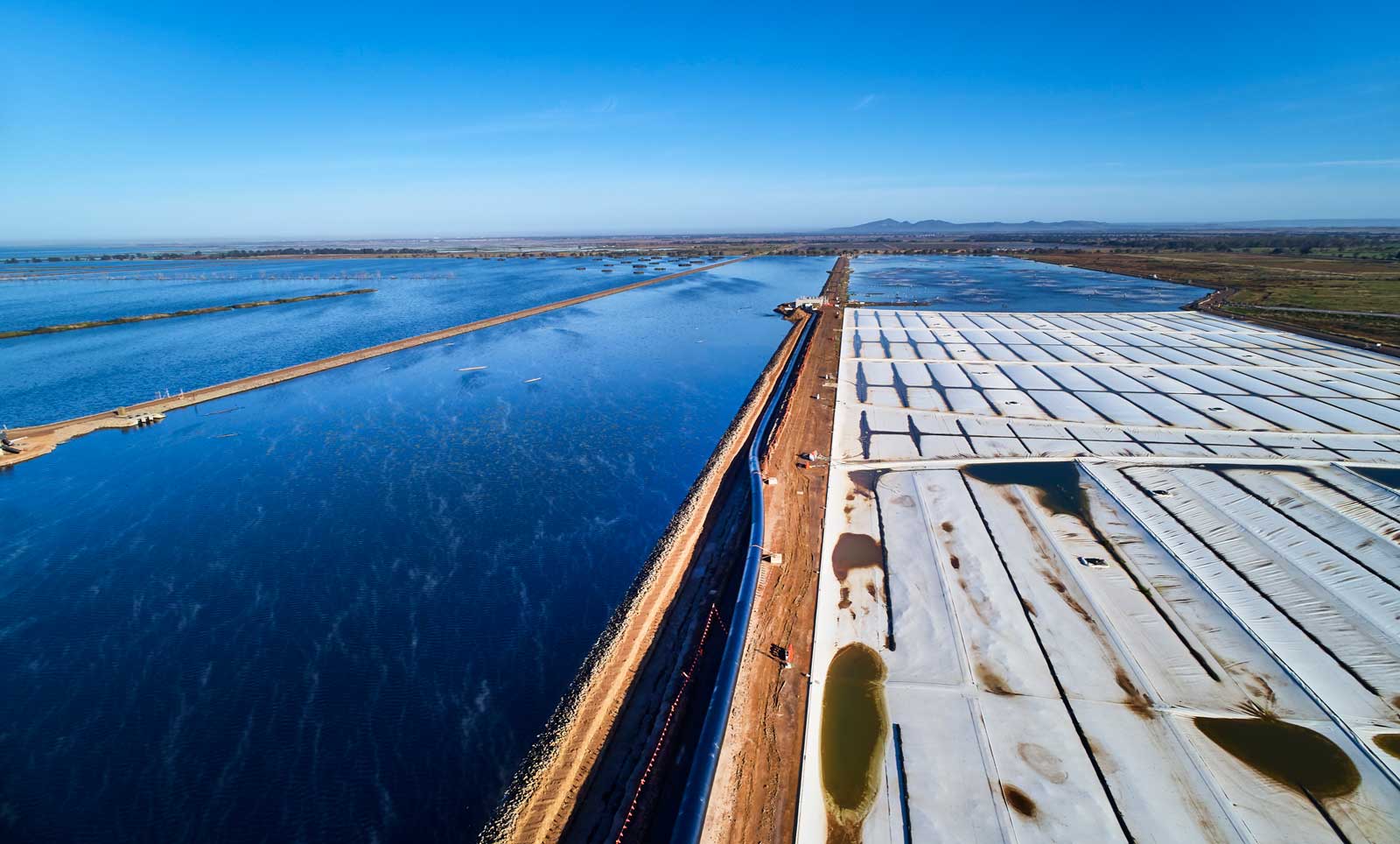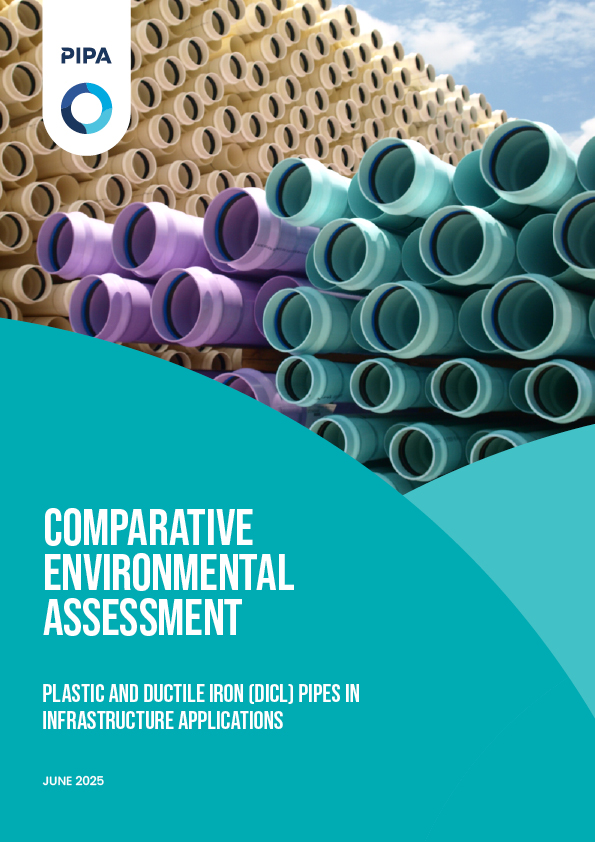Engineered for performance and recyclability, they offer safe, long-term infrastructure solutions.
PIPA is committed to advancing sustainability through the responsible use of plastic pipes. To better understand their environmental impact, we commissioned two independent LCAs comparing PE, PP, PVC-M, and PVC-O pipes with traditional materials like steel-reinforced concrete and ductile iron.
Using third-party verified EPDs tailored to Australian conditions, these assessments looked at all impact categories including carbon emissions, water usage, energy, and recyclability across the full life cycle. While no material excels in every category, plastic pipes show strong sustainability benefits—especially in reducing embodied carbon and water use—offering reliable, local data to guide smarter infrastructure decisions.

Drainage systems are essential to urban resilience and flood management, and the environmental impact of materials used in these systems can vary significantly. This report focuses on the comparative Life Cycle Assessment (LCA) of plastic pipes—specifically corrugated Polyethylene (PE) and Polypropylene (PP)—versus steel-reinforced concrete (SRC) pipes in drainage applications. Using consistent performance assumptions and Australian-specific Environmental Product Declarations (EPDs), the study examines environmental indicators including global warming potential, water consumption, and transport emissions across common pipe sizes (DN 375, DN 600, and DN 900).
The results reinforce the role of plastic drainage pipes as a lower-impact alternative, particularly where reducing embodied carbon and water use are key sustainability goals.
Plastic pipes emit 12–32% less CO₂ than concrete pipes across all sizes—from DN375 to DN900.
Plastic pipes use up to 56% less freshwater during manufacturing, making them a better fit for Australia's water-sensitive environment.
Lighter weight means 26–67% lower transport-related emissions compared to heavy concrete pipes.
Designed for 100-year use, plastic pipes are fully recyclable. Although the study focused on virgin resin, adding just 10–30% recycled content can substantially lower the carbon footprint.

Download the summary report: Environmental performance comparison – Plastic and concrete pipes in drainage applications.
Piping systems are foundational to sustainable infrastructure, and material choice plays a critical role in reducing environmental impact. This report presents a Life Cycle Assessment (LCA) comparison between plastic pipes—PE, PVC-M, and PVC-O—and traditional ductile iron cement-lined (DICL) pipes used in water applications. Focusing on common pipe sizes DN100 and DN300, the study applies consistent functional performance criteria and Australia-specific data to assess key environmental indicators such as carbon emissions, water use, and waste generation.
The findings indicate plastic pipes offer notable environmental advantages, including lower greenhouse gas emissions, significantly reduced water consumption, and minimal radioactive waste. These benefits, combined with lighter weight and local production advantages, highlight plastic pipes as the environmentally smarter choice for building climate-resilient infrastructure.
Plastic pipes produce significantly fewer greenhouse gases during manufacturing. For example, DN100 PVC-O pipes emit just 7 kg CO₂-eq per metre, compared to 37 kg for DICL pipes.
In a country where every drop counts, plastic pipes require up to 80% less freshwater during production—a critical advantage for Australian sustainability goals.
Lighter and often produced locally, plastic pipes have a smaller transportation footprint than heavier, imported DICL alternatives.
Plastic pipes outperformed DICL in most high-priority environmental indicators, including global warming potential, water usage, and ozone creation.

Download the summary report: Comparative Environmental Assessment – Plastic and Ductile Iron (DICL) pipes in Infrastructure applications.
Life Cycle Assessments (LCAs) measure and analyse the environmental impacts of a product or service, helping suppliers to improve their systems and make informed decisions.
When assessing two different products, it’s important to keep the following in mind
Plastic pipes are engineered for long service lives, often exceeding 100 years. Due to this performance expectation and strict industry standards, recycled materials are generally not used in their production — a factor that can make pipes with higher recycled content, like DICL, appear more favourable in LCAs, even though plastic pipes often excel in other environmental impact categories.
LCA results can vary based on where and how the underlying data is sourced. For example, plastic resin data is frequently based on global averages, but the actual environmental footprint may differ significantly when sourced from specific local producers. A more accurate comparison arises when both products are evaluated using data from the actual manufacturing location.
Direct comparisons between different materials and products can be challenging, as variations in composition, design, and manufacturing methods significantly affect outcomes. LCAs are highly sensitive to these specification differences, and it is essential to consider them when interpreting results.
The electricity mix used in resin production (e.g., fossil vs. nuclear vs. renewable sources) significantly affects LCA outcomes. As grid decarbonisation advances, especially in resin-manufacturing countries, the environmental performance of plastic pipes is likely to further improve.
This study focuses on the cradle-to-installation stages. Use-phase and end-of-life impacts were excluded, which limits a full cradle-to-grave understanding but provides robust insight into embodied impacts.
Differences in environmental assessment methods, such as between European EN standards and the ISO framework, can lead to variation in LCA outputs. Harmonisation is essential when comparing international products or using rating schemes that rely on older standards.
Comparing EPDs across different pipe materials or suppliers requires careful attention to consistency, methodology, and scope to ensure a meaningful and fair analysis:
Confirm that the products being compared serve the same function (e.g., drainage, pressure capacity) and have similar service lives. Without this, results may reflect performance discrepancies rather than material impacts.
EPDs must use the same declared unit (e.g., per metre of pipe) for a valid comparison. Differences in units can significantly distort comparative results.
Ensure that the EPDs cover equivalent life cycle stages. This study uses cradle-to-installation (A1–A5). Some EPDs may only include cradle-to-gate (A1–A3), which can underestimate total impacts.
LCA results vary based on data sources. For example, resin data in plastic pipe EPDs may reflect global averages, whereas concrete EPDs might use locally sourced information. For accurate comparisons, data origin and type (primary vs. secondary) must be aligned.
Check that EPDs follow the same methodological framework (e.g., EN 15804+A2). Older EPDs using EN 15804+A1 or ISO 14025 may not be directly comparable due to differences in impact assessment approaches.
Confirm that the EPDs include the same set of environmental indicators, such as global warming potential (GWP), water use, eutrophication, and waste generation. Gaps in impact categories may skew comparison.
Some materials like concrete incorporate significant recycled content (e.g., steel reinforcement), whereas plastic pipes currently use virgin resins. Understanding how recycled content is treated in each EPD is essential for fair evaluation.
Based on the Building Research Establishment (BRE) prioritisation, these 13 environmental impact categories are commonly used in building life cycle assessments to evaluate the environmental effects of construction products and buildings. They provide a comprehensive framework to quantify impacts and support sustainable decision-making in the built environment.